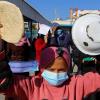
Policy Brief #43, April 2024. Beyond the current conflict, longstanding issues must be addressed to ensure lasting food security in the Gaza Strip.
In the Gaza Strip, more than 95% of the population is in a state of acute food insecurity and 30% is experiencing famine, with the situation expected to worsen. The ongoing Israel-Hamas War, which commenced in October 2023, is a major contributor to this crisis. However, there are several other food-security challenges in Gaza that predate the outbreak of war.
Besides the impacts of recent conflict, new IIASA research shows that past and present governance issues, as well as a failure to effectively implement food-security policy, are significant contributors to the food crisis in Gaza.
To address the current crisis and ensure lasting food security, strategies are needed that address not only the impacts of recent conflict, but also these underlying issues.
Specifically, the research recommends:
- The lifting of restrictions on access to humanitarian aid in the Gaza Strip, including food, water, energy, and medical supplies.
- Decisive action from the international community to address immediate needs and root causes of Gazan food insecurity, including documented instances of government misuse of aid.
- Global efforts to encourage the Gazan government to invest in social equity, prioritize food security, health, and other vital aspects, and increase transparency and accountability.
- A combined approach of comprehensive support for the Gazan people and firm pressure for responsible governance in the Gaza Strip.
Immediate impacts of war
Key issues
- Destruction and loss of life from attacks, airstrikes, and ground invasion.
- A blockade preventing the movement of food, water, and other essential supplies.
- Chronic food insecurity and the threat of widespread famine.Alleged corruption and violent exploitation of aid by Gazan government officials.
War is undeniably a major contributor to Gaza’s current food security crisis. The Israel-Hamas War commenced on 7 October 2023, following a large-scale attack against Israel by Hamas and its allies from the Gaza Strip. Israel responded with airstrikes, a blockade, and a ground invasion of Gaza, leading to large-scale destruction and loss of life on both sides. As of late April 2024, attempts by the international community to establish a lasting ceasefire have not been successful.
The Integrated Food Security Phase Classification (IPC) Famine Review Committee (FRC) has been activated to monitor conditions in the Gaza Strip, using the IPC scale to assess indicators of food security, nutrition, and livelihoods. The scale ranges from Phase 1, where households have adequate access to food, to Phase 5, where households experience extreme lack of food and a failure to meet basic needs, despite the full employment of coping strategies. IPC investigations have found that:
- More than 2.1 million people in Gaza, 95% of the population, are experiencing acute food insecurity.
- More than 90% of the Gazan population is classified as facing “crisis”, “emergency”, or “catastrophe” conditions (IPC Phases 3, 4, or 5).
- Famine (“catastrophe”, Phase 5) has become reality for 30% of the population, with this figure expected to increase.
- Reports by the Food and Agriculture Organisation of the United Nations (FAO) and the International Food Policy Research Institute (IFPRI), a CGIAR Research Center, have underscored these findings, indicating concern about chronic food insecurity in the Gaza Strip and the serious threat of widespread famine.
At the same time, observer reports by the United Nations, USAID, and others have alleged exploitation by Gazan government officials of humanitarian aid intended for civilians.
Reports allege instances of officials seizing control of food aid, and even violently assaulting residents attempting to access supplies. Similar reports have been made regarding fuel and electricity supplies, and financial aid. These alleged actions have drawn condemnation from international organizations, with concerns raised about the wellbeing of the Gazan population.
Longstanding policy and governance issues
Key issues
- Weaker food security governance and policy implementation in the Gaza Strip compared to the West Bank.
- Failure to moderate erratic food price fluctuations in Gaza.
- Impact of global markets on local food prices including bread as a staple food.
- Alleged corruption and suppression of dissenting views by Gazan authorities, impacting effective policy implementation.
Beyond the impacts of war, the Gaza Strip faces longstanding issues related to food security policy and governance. IIASA research has traced trends back to 2007, the pivotal year when the State of Palestine was divided into two entities: the West Bank and the Gaza Strip. An analysis of local and international reports, as well as food price fluctuations over the period, reveals differences in the experiences of the two territories, suggesting differences in food security governance and policy implementation.
Local and international reports indicate that food security strategies have long been in place in both territories. A statewide strategy for Palestine, including a plan for the stabilization of food prices, has been active since at least 2008, according to technical reports from the Ministry of Health Nutrition Department (MHND) and the Ministry of Agriculture (MA) under the Palestinian National Authority.
Reports by international organizations such as the FAO, the World Bank, and others during this period confirm that a multifaceted approach to food security has been pursued, including measures to stabilize markets, improve income opportunities, and strengthen social safety nets to mitigate negative impacts on vulnerable populations.
Yet IIASA’s analysis of food prices over this period shows that despite taking similar strategies, the West Bank has been more successful than the Gaza Strip in stabilizing food prices and ensuring food security for its population (see Figure 1), suggesting important governance and policy differences. In the Gaza Strip, food prices have continued to fluctuate erratically over the years, with variations more closely linked to global wheat prices than to local security crises.
Figure 1. Measurement of food price instability in West Bank and Gaza Strip since 2007. Left: Moving standard deviation (quarterly) of the nominal consumer bread price. The shaded coloured areas correspond to significant armed events in recent history: Operation Cast Lead (1), Operation Protective Edge (2), the 2021 Israel–Palestine crisis (3), and the Israel–Hamas war (4). Right: Monthly price volatility of other staples, prior to
October 2023.
The research further considers Israel’s tight control over the economy of the Palestinian territories, as a factor in the delayed development process of both the West Bank and the Gaza Strip.
The analysis finds that since 2007:
- The West Bank displayed relative stability in food prices over time, and improved moderation of price fluctuations, possibly due to effective governmentled food security initiatives.
- The West Bank showed efforts to stabilize bread prices, highlighting a potential contrast in governance approaches with the Gaza Strip.
- In the Gaza Strip, prices of all staple foods, especially rice and sugar, continued to fluctuate erratically over the years.
- A closer look at bread, the main staple food in the Palestinian diet, showed that variation in bread prices was more closely linked to global wheat prices than to local security crises.
- Inconsistency in pricing in the Gaza Strip continues to be exacerbated by ongoing allegations of corruption and suppression of dissenting views by Gazan authorities, raising questions about their efficacy in putting the planned food-security strategy into action.
Conclusions
The research concludes that beyond the impact of war, past and present governance issues including failure to effectively implement food-security policy, are significant contributors to the current food-security crisis in Gaza. Future strategies therefore need to address not only the impacts of recent conflict, but also these underlying issues.
In summary, ending the crisis in the Gaza Strip and preventing imminent famine requires urgent actions related to conflict:
- An end to the blockade.
- Action from the international community to supply aid directly to civilians, preventing misuse of aid.
Additionally, long-term actions from the global community are required to support improvements in:
- Effective implementation of food security strategies.
- The development of responsible governance in Gaza, including increased transparency and accountability.
- Measures to improve the wellbeing of the Gazan population.
Acknowledgements
The authors would like to acknowledge Elena Rovenskaya, Leonidas-Romanos Davranoglou, and Catriona Richards for their support in producing this brief.
References
Food and Agriculture Organization of the United Nations (FAO), World Food Programme (WFP), and the United States Agency for International Development (USAID) (2003). Report of the food security assessment West Bank and Gaza Strip.
Integrated Food Security Phase Classification (IPC) (2024, March). Famine Review Committee: Gaza Strip, March 2024.
IPC (2024, January). Gaza Strip: Hostilities leave the entire population highly food insecure and at risk of famine.
IPC (2023, 21 December). Gaza Strip: Famine review of the IPC analysis.
Ministry of Agriculture, Palestinian National Authority (MA) (2016, 1 November). National agricultural sector strategy (2017-2022) resilience and sustainable development. Technical report.
Ministry of Health Nutrition Department, Palestinian National Authority (MHND) (2008, 8 June). Palestinian national nutrition policy and strategy and operational plan of action for nutrition. Technical report.
Vos, R; Elouafi, I & Swinnen, J. (2024, 18 March). Famine in Gaza. International Food Policy Research Institute (IFPRI).
Vos, R. (2023, 22 December). The population of Gaza is on the brink of famine.
World Bank (2022). Economic monitoring report to the Ad Hoc Liaison.
This policy brief was authored by Rotem Zelingher (IIASA).


